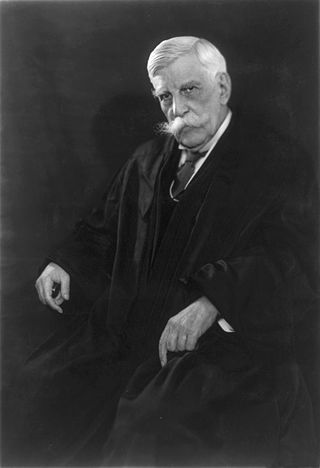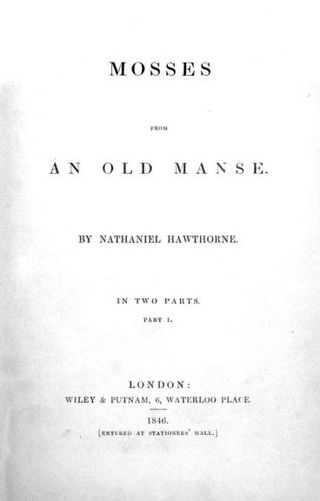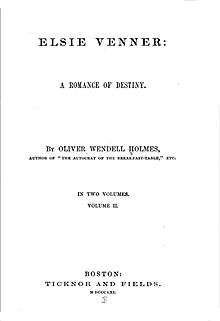
Herman Melville was an American novelist, short story writer, and poet of the American Renaissance period. Among his best-known works are Moby-Dick (1851); Typee (1846), a romanticized account of his experiences in Polynesia; and Billy Budd, Sailor, a posthumously published novella. At the time of his death, Melville was no longer well known to the public, but the 1919 centennial of his birth was the starting point of a Melville revival. Moby-Dick eventually would be considered one of the great American novels.

Moby-Dick; or, The Whale is an 1851 novel by American writer Herman Melville. The book is the sailor Ishmael's narrative of the maniacal quest of Ahab, captain of the whaling ship Pequod, for vengeance against Moby Dick, the giant white sperm whale that bit off his leg on the ship's previous voyage. A contribution to the literature of the American Renaissance, Moby-Dick was published to mixed reviews, was a commercial failure, and was out of print at the time of the author's death in 1891. Its reputation as a Great American Novel was established only in the 20th century, after the 1919 centennial of its author's birth. William Faulkner said he wished he had written the book himself, and D. H. Lawrence called it "one of the strangest and most wonderful books in the world" and "the greatest book of the sea ever written". Its opening sentence, "Call me Ishmael", is among world literature's most famous.
This article contains information about the literary events and publications of 1861.

Oliver Wendell Holmes Jr. was an American jurist who served as an associate justice of the U.S. Supreme Court from 1902 to 1932. Holmes is one of the most widely cited Supreme Court justices and among the most influential American judges in history, noted for his long service, pithy opinions—particularly those on civil liberties and American constitutional democracy—and deference to the decisions of elected legislatures. Holmes retired from the court at the age of 90, an unbeaten record for oldest justice on the Supreme Court. He previously served as a Brevet Colonel in the American Civil War, in which he was wounded three times, as an associate justice and chief justice of the Massachusetts Supreme Judicial Court, and as Weld Professor of Law at his alma mater, Harvard Law School. His positions, distinctive personality, and writing style made him a popular figure, especially with American progressives.

Oliver Wendell Holmes Sr. was an American physician, poet, and polymath based in Boston. Grouped among the fireside poets, he was acclaimed by his peers as one of the best writers of the day. His most famous prose works are the "Breakfast-Table" series, which began with The Autocrat of the Breakfast-Table (1858). He was also an important medical reformer. In addition to his work as an author and poet, Holmes also served as a physician, professor, lecturer, inventor, and, although he never practiced it, he received formal training in law.

"Old Ironsides" is a poem written by American writer Oliver Wendell Holmes Sr. on September 16, 1830, as a tribute to the 18th-century USS Constitution. The poem was one reason that the frigate was saved from being decommissioned, and it is now the oldest commissioned ship in the world that is still afloat.

Pequod is a fictional 19th-century Nantucket whaling ship that appears in the 1851 novel Moby-Dick by American author Herman Melville. Pequod and her crew, commanded by Captain Ahab, are central to the story, which, after the initial chapters, takes place almost entirely aboard the ship during a three-year whaling expedition in the Atlantic, Indian and South Pacific oceans. Most of the characters in the novel are part of Pequod's crew.

Arrowhead, also known as the Herman Melville House, is a historic house museum in Pittsfield, Massachusetts. It was the home of American author Herman Melville during his most productive years, 1850–1863. Here, Melville wrote some of his major works: the novels Moby-Dick, Pierre, The Confidence-Man, and Israel Potter; The Piazza Tales ; and magazine stories such as "I and My Chimney".

The Dante Club is a mystery novel by Matthew Pearl and his debut work, set amidst a series of murders in the American Civil War era. It also concerns a club of poets, including such historical figures as Henry Wadsworth Longfellow, Oliver Wendell Holmes Sr., and James Russell Lowell, who are translating Dante Alighieri's Divine Comedy from Italian into English and who notice parallels between the murders and the punishments detailed in Dante's Inferno.

The Autocrat of the Breakfast-Table (1858) is a collection of essays written by Oliver Wendell Holmes Sr. The essays were originally published in The Atlantic Monthly in 1857 and 1858 before being collected in book form. The author had written two essays with the same name which were published in the earlier The New-England Magazine in November 1831 and February 1832, which are alluded to in a mention of an "interruption" at the start of the first essay.

Lesbia Harford was an Australian poet, novelist and political activist. She was one of the first women to study law degree at the University of Melbourne. She agitated for the rights of workers, supporting a group of union workers who were imprisoned for treason and other crimes. A later reading of Harford's poetry and biography have raised her profile as a pioneer of 'free love' and a queer icon.

Harriot Kezia Hunt was an American physician and women's rights activist. She spoke at the first National Women's Rights Conventions, held in 1850 in Worcester, Massachusetts.

Charles Wentworth Upham was a U.S. Representative from Massachusetts. Upham was also a member, and President of the Massachusetts State Senate, the 7th Mayor of Salem, Massachusetts, and twice a member of the Massachusetts State House of Representatives. Upham was the cousin of George Baxter Upham and Jabez Upham. Upham was later a historian of Salem and the Salem Witch Trials of 1692 when he lived there.

Percy Langdon "Bullet" Wendell was an American football player and coach of football and basketball. He played college football at Harvard University, where he was a three-time All-American from 1910 to 1920. Wendell served as the head football coach at Boston University in 1920, at Williams College from 1921 to 1924, and at Lehigh University from 1925 to 1927, compiling a career college football coaching record of 30–33–4. He was also the head basketball coach at Boston University for one season, in 1919–20, tallying a mark of 0–6. Wendell was elected to the College Football Hall of Fame as a player in 1972.

The Saturday Club, established in 1855, was an informal monthly gathering in Boston, Massachusetts, of writers, scientists, philosophers, historians, and other notable thinkers of the mid-19th century.

Thomas Melvill or Thomas Melville was a merchant, member of the Sons of Liberty, participant in the Boston Tea Party, a major in the American Revolutionary War, a longtime fireman in the Boston Fire Department, state legislator, and paternal grandfather of writer Herman Melville.

"Hawthorne and His Mosses" (1850) is an essay and critical review by Herman Melville of the short story collection Mosses from an Old Manse written by Nathaniel Hawthorne in 1846. Published pseudonymously by "a Virginian spending July in Vermont", it appeared in The Literary World magazine in two issues: August 17 and August 24, 1850. It has been called the "most famous literary manifesto of the American nineteenth century."

The New-England Magazine was a monthly literary magazine published in Boston, Massachusetts, from 1831 to 1835.

Homœopathy and Its Kindred Delusions is a work by Oliver Wendell Holmes Sr., based upon two lectures he gave in 1842, Medical Delusions and Homœopathy. The work criticizes homeopathy, which he considered to be akin to "astrology, palmistry and other methods of getting a living out of the weakness and credulity of mankind and womankind". It is considered to be a classic text, one of Holmes' most important works, as well as one of the earliest criticisms of homeopathy.
Sarah Morewood (1823–1863) was a poet and literary figure who developed a close relationship in the 1850s with her nearest neighbor in the Berkshires, the novelist Herman Melville. In 1983 Professor Michael Rogin of the University of California, Berkeley, was the first to suggest that Morewood was a model for the character of Isabel in Melville's dark novel of romance and ambition Pierre; or, The Ambiguities (1852). Thirty-three years later biographer Michael Shelden argued in Melville in Love (2016) that Morewood influenced Melville's work not only in Pierre, but also in Moby-Dick (1851), and that for much of the 1850s the two were lovers.



















